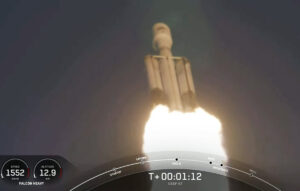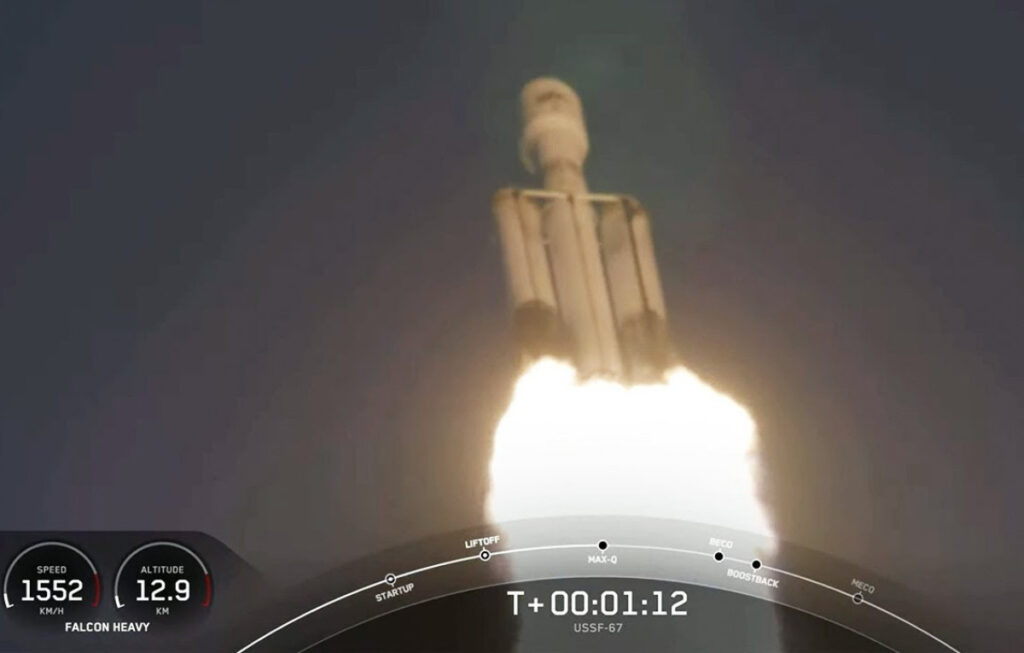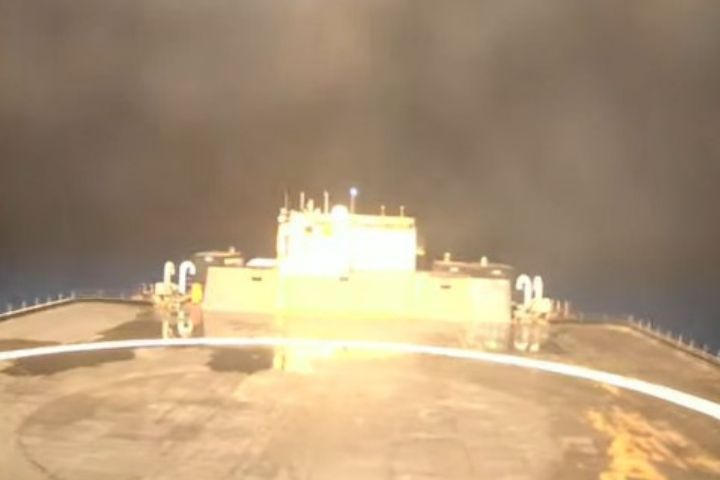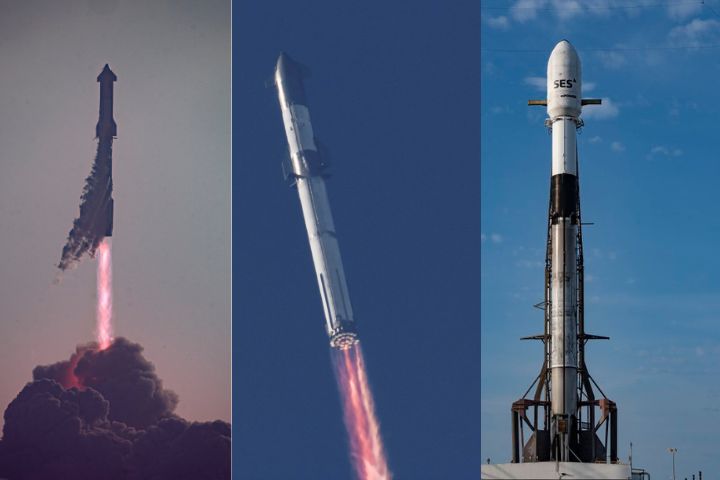
The launch of the Soyuz MS-23 to replace the leaky Soyuz MS-22 and the exciting construction of the Starship and Starbase are just two aspects of this ever-expanding fascinating story.
Even though Perseverance has been on Mars for two years, the future looks even more amazing.
Additionally, we have some exciting news for all Kerbal Space Program fans.
Yes! Get ready.
This one has a lot going on!
First up today is the testing that Booster 7 went through over the weekend. I have to say that that day’s testing was very interesting.
The usual tank farm venting was the first thing that happened, but before we loaded cryogenics onto the booster, we had another full-speed Booster Quick Disconnect or BQD retraction test. Shortly after that, it once more engaged with the booster.
A frostline started to appear on the Liquid Oxygen tank shortly after the subchiller venting increased.
We experienced this shortly after the propellant load was completed.
Was that a spin prime test with just one engine that we saw there?
Since it lacks the typical force associated with a spin prime test, we are unable to say for sure.
That, in case you aren’t aware, is an engine test in which propellant flows through turbo pumps that are brought up to speed.
There is no fire.
In contrast to the more recent tests, the Fire Suppression system was not operating either, which made it appear intriguing.
Another retraction test of the BQD, this time with the cryogenics still loaded in Booster 7, continued testing.
Just take a look at the escaping that came from that brief disconnect.
This marked the end of the day’s testing.
Now, one excellent piece of information about the upcoming orbital test flight that I believe was somewhat underreported was that SpaceX security space senior advisor Gary Henry provided some interesting details at the Space Mobility conference earlier this week.
After the 31 engine static fire, he stated, the Super Heavy booster and its launch pad were in good condition.
With the exception of, of course, the FAR’s final approvals, this was actually the final significant obstacle.
This is fantastic news because I believe they won’t need to hold any more significant static fire events before the launch, which I hope will still take place in March.
More testing on Tuesday, with the road closing at 8 a.m.
The curious question was, what would be tested?
Given that SpaceX had parked a lot of the equipment nearby, including a Ship transport stand, Ship 25 was unlikely.
The Orbital Launch Mount work platform was still being raised, so Booster 7 was out of the picture as well.
Yes, it was time for Ship 26’s first test!
A few new vents on suborbital pad A brought the suborbital tank farm to life, and we quickly learned that the crew was indeed loading cryogenics into Ship 26.
probably in liquid nitrogen.
The oxygen tank was almost completely full after a few hours.
The methane tank’s frost also began to rise quickly.
Before the test was over, a significant amount of propellant entered that tank and it began to unload.
This was actually a pretty cool effect because it almost looked like the vehicle had three tanks for propellant.
Obviously, that was just how the frost was melting, but I’m sure some people were confused by it.
In a previous episode, we discussed the possibility that these cryogenic proofing tests could be performed at Masseys instead, saving SpaceX the safety risk of having to shut down the entire orbital launch site and prevent access to the beach.
This is one question that I’m sure some of you have asked.
How would SpaceX carry out the Masseys thrust puck testing?
With these hydraulic rams, they basically apply stress to the vehicle’s undercarriage to mimic the force of the Raptor engines at full thrust.
Actually, that could be a fairly straightforward response!
Previously, SpaceX only tested the puck on a new Ship revision during the suborbital hop period.
However, with the design now maturing, it is hoped that this will not be required for each new Ship.
Booster 9 is already an illustration.
Booster 9, on the other hand, has only carried out a few cryo tests on its transport stand, in contrast to Booster 7, which spent a lot of time on the can crusher for these tests.
So, let’s take a look at the Masseys website!
The progress has been absolutely massive over the past few weeks.
The main cryogenic pipes are now nearly at the Ship cryostation here, and we can see that the tankfarm is making significant progress once more.
This has a structure that is very similar to the one they use at the Orbital launch site.
The Quick Disconnect interface resembles the other Ship plates at Starbase, including the two on the suborbital pads and the cryostation.
You might be wondering about the Ships after all of this discussion: how is Ship 27 performing?
This week, the thrust, middle liquid oxygen, and common dome sections of its tank were relocated inside the highbay.
At the time, SpaceX covered the top of this with a tarp to prevent debris from entering, I imagine.
Teams added an outside walkway made of scaffolding later in the week.
Additionally, this was close to the top of the tank section, indicating the impending stack.
That brings the total number of fully stacked ships to four, there we go!
Since it certainly appears that they want that cryostation to be ready for use in a timely manner, it’s possible that SpaceX intends to conduct the initial cryogenic proof testing on this one at the Masseys site.
Ship movement also increases.
Here, the testing base was elevated above the structural test nosecone.
One you might not have seen is that this nosecone is totally loaded with sensors for its impending trying with what we’ve been calling the nose cone testing prison.
That test will be fascinating.
Additionally, it has been welded onto a single ring with a crew access hatch.
It’s quite an intriguing device, so let’s take a quick look at the base it will be tested on.
This extension in the middle, with what appear to be three large pistons on top, is immediately visible.
Two weeks ago, those pistons had eyes mounted on top; however, for unknown reasons, those eyes were removed.
Now, how does everything work?
I believe that ropes will be attached to those three pistons, pulling down on the nosecone’s top.
They will be able to simulate the nosecone experiencing maximum aerodynamic pressure in this manner.
The cap that will be raised to the top actually contains some of these ropes, which can be seen there.
Therefore, I believe that SpaceX will move this rig toward the Masseys site to carry out the testing there now that that nosecone is on the base.
Based on the most recent RGV flight, we can see that the jail structure for the nosecone was split in half at that point and was getting ready to be lifted above the nose cone, which was still at the Buildsite.
Ship 25 also received some attention from SpaceX.
It was lifted from suborbital pad B with the SpaceX crane attached and the chains fastened to the aft flaps. This was kind of strange because it had been resting here since January 17 without any testing.
at the very least, no major testing.
So, around this time, the community starts asking questions, wondering if it will be scrapped because it is already outdated, moved to the Buildsite for temporary storage, or even made ready for an orbital flight.
SpaceX parked it here in the ringyard after it was rolled back to the construction site, so that is all we know at this point.
Okay, on to Booster 7 and the orbital launch site.
I mentioned last week that it received a brand-new hydraulic power unit with serial number 15.
This week, however, another one, serial number 14, was installed.
RGV was able to spot both of the HPU aerocovers that were delivered to the launchsite during this week’s flyover.
One of them is being attached, as seen here.
Last week, I mentioned the possibility of the covers and shielding on the outside of the Orbital Launch Mount being installed soon.
SpaceX began installing them early in the week, so don’t wait any longer!
The first cover was just a plain one, and the next day, a second piece with a door was put in.
What, wait?
Yes, that appears to be a door leading nowhere?
It certainly appears to be a substantial blast-resistant door that can be opened from both the inside and outside.
Additionally, I have a feeling that they may desire this door so that they can raise larger equipment.
parts like brand-new control valves or sections of pipe, among other things.
They will be able to enter directly into the interior walkway whenever they need to, which will be useful.
Additionally, SpaceX installed these stairs, which separate from the main staircase and ascend the orbital launch mount further.
When the work platform is raised, this ought to make it simpler for the crew to ascend to it.
That would be fantastic because it would mean that they wouldn’t have to use these scissor lifts or other similar equipment just to get up here.
When there is no testing going on, the platform actually spends the majority of its time raised, which also protects the booster from the elements.
Additionally, Starship Gazer was able to spot the arrival of a second protective hood for the Booster Quick Disconnect’s back.
Additionally, shortly thereafter, that was installed.
Midway through the week, work on the Orbital Launch Mount shield continued.
We were able to observe that multiple pieces had been installed overnight and that additional pieces had been added since Thursday’s spectacular sunrise.
Another entry point is provided by the presence of a door in one of the other installed pieces.
I will say that it will be wonderful to see the entire launch mount with the intricate internal mechanisms shielded by complete external shielding.
As a result, the Progress spacecraft undocked as we discussed the MS-21 leak last week.
Since then, there have been many more topics to discuss.
If you are up to date on this, you may have seen images of the leak area taken while the spacecraft was rotating from the International Space Station.
That provided a clearer picture of the presumed leak point and offered some clues as to why it occurred.
The Progress spacecraft made its final deorbit burn almost a day later, and shortly thereafter, it re-entered over the Pacific Ocean.
After that, Roscosmos said that the Soyuz MS-23 rescue capsule, which was supposed to safely get the three crew members back, was going to launch on February 24.
Since Roscosmos had previously stated that they would take their time to thoroughly inspect this new rescue Soyuz, all of this was somewhat perplexing.
This launch was previously stated to take place no earlier than March 10.
In any case, Roscosmos provided additional information regarding the enigmatic leaks as this one was getting ready to be rolled to the pad.
First, this brand-new video in which the Progress MS-21’s radiator leaks coolant.
This was something we hadn’t seen before, and compared to the Soyuz MS-22, it doesn’t appear to be as intense.
Now, this could be a minor leak, or it could simply be different timing or backlighting between the two clips.
That’s still up in the air.
But yes, let’s just take a second look at the image to see where the new leak has damaged the area.
A tiny hole with a diameter of approximately 12 millimeters can be seen right there.
Roscosmos claims that an “external influence” was to blame for the leak.
However, I suppose this is the mystery, isn’t it?
Simply comparing this to the image of the Soyuz MS-22 reveals that the tiny holes occurred in very similar locations.
It seems unlikely that the same issue would occur twice in a row in a similar location at random.
However, you never know.
It would be pretty poetic if these issues were caused by debris from the destroyed Cosmos 1408 satellite—not that it could ever be determined.
Naturally, Russia made the decision to destroy this during a demonstration anti-satellite missile test in 2021.
a test that produced this enormous cloud of debris, which could be a problem for any vehicle whose orbits intersect.
In any case, this brings us to the Soyuz MS-22 rescue mission.
The ISS-cargo-laden, uncrewed Soyuz MS-23 was getting ready to launch from Kazakhstan’s Baikonur Cosmodrome late this week.
As it roared off the pad, we see that brilliant fire plume.
At first, slowly, with a thrust to weight ratio of about 1.
4.As it got ready for the quadruple strap-on boosters to eject and create the always entertaining Korolev cross, it quickly gained momentum throughout the flight.
Naturally, everything went well.
Nowadays, it is extremely rare for a Soyuz launch to fail.
It takes a very long time to get to the station, and it won’t actually dock until after this video goes live on Saturday.
Therefore, the two cosmonauts Sergey and Dmitry, as well as NASA’s Frank Rubio, now have a brand-new vehicle in which to return home.
After rearranging all of the seat liners so that they can fit into the new vehicle, their damaged craft, MS-22, will be autonomously returned sometime in the next month.
However, the fact that the crew will need to remain aboard the ISS for a significant amount of time yet is interesting.
The Soyuz MS-24 with a new crew will arrive in September, right around the time of their return.
It stands to reason that MS-23 was their initial aircraft.
a mission that lasted much longer than any of the crew initially anticipated, given that they would normally be returning home in the coming weeks.
The perseverance rover’s landing in Jezero Crater on Mars doesn’t seem that long ago, does it?
However, can you believe it has been over two years since then?
Yes, that’s right!
That was the length of its planned mission, and it passed with flying colors, as predicted.
In addition to a few surface-based robotic friends and a small fleet of orbiting spacecraft; Our current objectives for studying the Martian environment continue to set new ground thanks to perseverance.
Naturally, its primary objective is to investigate the ancient river delta that traversed Jezero Crater approximately three and a half billion years ago, with the hope of locating evidence of life’s past existence.
All of this to assist in answering the query, “Are we alone in the universe?”
Over the past 24 months, it has been both jaw-dropping and awe-inspiring to watch the Perseverance rover’s little companion, the Ingenuity helicopter, progress.
Frequently taking center stage with this impressive display of extraterrestrial aviation.
Because of its robust design, Ingenuity’s initial mission objectives have long since been replaced by its current missions.
dozens of successful flights, each of which was frequently longer, higher, and faster than the previous one.
These missions went from being a simple proof of concept to a solid scouting platform that laid the groundwork for the next generation of aerial spacecraft.
In fact, it’s possible that the next ones headed for Mars have already been chosen.
You have to understand that the rover has been busy collecting a variety of surface samples, some of which have been returned to the surface in these tiny backup capsules.
Perseverance itself still contains the primary ones.
It is intended to place them in a subsequent sample retrieval lander; however, what about the ones that are already on the surface?
Helicopters may be attempting to collect those, according to Well Sample Recovery.
I have to say that will be pretty amazing to witness.
Naturally, the entire endeavor also serves as an introduction to the first crewed Mars missions.
If we want the first human landings and excursions to go as smoothly as possible, we must first gain confidence and familiarity on the surface.
Now, in my opinion, Kerbal Space Program 2 is a big highlight of the week!
On February 24, its Early Access release date was set.
YES!
Yesterday was that.
I’m overjoyed about this because I’ve been a fan of the original game for a long time!
In point of fact, my enthusiasm for the game was the very thing that initially prompted me to establish a channel on YouTube.
If you’ve never played Kerbal Space Program before, you’re missing out on a fantastic chance to learn about rocket science and space travel.
It’s a great way to learn about basic rocket development, orbital mechanics, mission planning, and other topics as well as a blast.
And believe me, when things start going wrong, the fun really starts!
I definitely don’t lack that experience.
I’ve probably played this game for thousands of hours, and I can’t wait to see what this new version has in store for me.
However, before you start playing, keep in mind that the early access version lacks a few features that some people might have expected.
There is currently no multiplayer, no career or science mode, no interstellar travel, no colonies, or anything like that.
Additionally, the colossal performance requirements at this early stage caught many people off guard, so verify them before committing.
That will, I’m sure, be reduced by a lot of optimization in subsequent releases.
However, I would advise you not to be discouraged by any of the missing items!
There is still a lot of fun to be had even in the sandbox mode.
It is also easier than ever to participate in the action because the game is only available for PC during this early access period on Steam, the Epic Games Store, and the Kerbal Space Program website.
Yep. Even if only in sandbox mode, it is time for me to start playing again.
I will admit that I am somewhat rusty, but I cannot wait!
Also, keep in mind that, assuming the schedule holds, the Crew-6 mission will start within the next few days and that the crew arrived early in the week.
The Russian cosmonaut, UAE astronaut, and two NASA astronauts addressed the audience about their missions, which I found to be quite interesting.
That is linked in the following description.
From Launch Complex 39A, the Crew Dragon-laden Falcon 9 rocket will take off, and SpaceX recently released these images of the vehicle.
Dragon Endeavour crew.
the same one that took off with Bob and Doug on SpaceX’s first crewed flight and flew on Axiom Mission 1 in April of last year.
Oh my god, where have those ten months gone?
Regardless, keep an eye out for that huge event.











